
Satureja is a genus of aromatic plants of the family Lamiaceae, related to rosemary and thyme. It is native to North Africa, southern and southeastern Europe, the Middle East, and Central Asia. A few New World species were formerly included in Satureja, but they have all been moved to other genera. Several species are cultivated as culinary herbs called savory, and they have become established in the wild in a few places.

The Ozarks is a physiographic region in northern Arkansas and southern Missouri, United States.

Calamintha is a genus of plants that belongs to the family Lamiaceae. Commonly called the calamints, there are about eight species in the genus which is native to the northern temperate regions of Europe, Asia and America.

Kakamega Forest is a tropical rainforest situated in the Kakamega and Nandi County of Kenya, northwest of the capital Nairobi, and near to the border with Uganda. It is Kenya's only tropical rainforest and is said to be Kenya's last remnant of the ancient Guineo-Congolian rainforest that once spanned the continent.
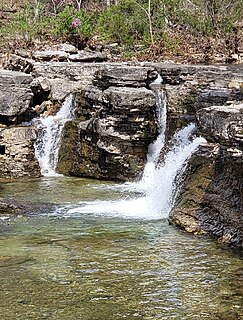
The Hercules Glades Wilderness is a 12,314-acre (50 km2) wilderness area in Taney County in the Ozarks of southwest Missouri. The United States Congress designated it a wilderness in 1976, making it the oldest wilderness area in Missouri. It is one of eight wilderness areas in the Mark Twain National Forest and is within the Ava-Cassville-Willow Springs ranger district, about 10 miles (16 km) northeast of Branson, Missouri. Hercules Glades Wilderness derives its name from the open limestone glades (balds) that dot its landscape. The high points of Coy Bald and Pilot Knob stand 600 feet above Long Creek and offer splendid views of the drainage. Near the middle of the wilderness area is the main set of waterfalls, though Long Creek has several other smaller waterfalls and cascades along its path.
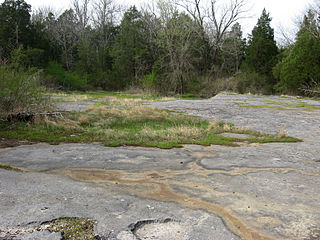
A calcareous glade is a type of ecological community that is found in the central eastern United States. Calcareous glades occur where bedrock such as limestone occurs near or at the surface, and have very shallow and little soil development. Because of the shallow soil and the extreme conditions created by it, trees are often unable to grow in the glades. This creates a habitat that is usually sunny, dry, and hot. Calcareous glade vegetation is more similar to that of a desert habitat than a grassland, being dominated by small spring annuals with occasional geophytic or succulent perennials.

Clinopodium is a genus of flowering plants in the family Lamiaceae. It is in the tribe Mentheae of the subfamily Nepetoideae, but little else can be said with certainty about its phylogenetic position.
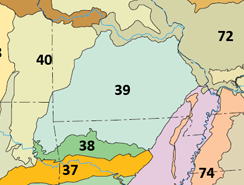
The Ozark Highlands is a Level III ecoregion designated by the Environmental Protection Agency (EPA) in four U.S. states. Most of the region is within Missouri, with a part in Arkansas and small sections in Oklahoma and Kansas. It is the largest subdivision of the region known as the Ozark Mountains, less rugged in comparison to the Boston Mountains in Arkansas, the highest part of the Ozarks.
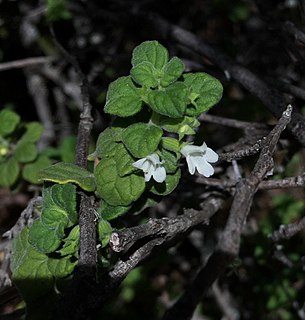
Clinopodium chandleri is an uncommon species of flowering plant in the mint family known by the common name San Miguel savory. It is native to northern Baja California and several areas of southern California, where it can be found in mountain chaparral. A fragrant plant with white flowers, it is one of southern California's rarest shrubs.
"Wild basil" is a common name for several plants in the mint family (Lamiaceae):

Stephensia brunnichella is a moth of the family Elachistidae found in Europe and east into the Palearctic.
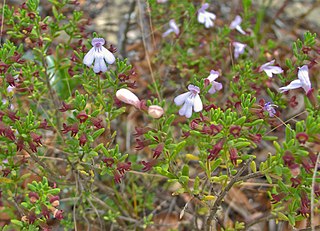
Clinopodium ashei is a species of flowering plant in the mint family known by the common names Ashe's savory and Ashe's calamint. It is native to Florida and Georgia in the United States.

Clinopodium dentatum is a species of flowering plant in the mint family known by the common names toothed savory and Florida calamint. It is native to Florida and Georgia in the United States.

Phemeranthus calcaricus, the limestone fameflower, is a species of flowering plant in the family Montiaceae. It is native to limestone glades of the Interior Low Plateaus of Tennessee, Kentucky, and Alabama, and in the Ozark Mountains of Arkansas. The majority populations are found in the Nashville Basin of Tennessee, where it can be locally abundant on exposed limestone in high quality glades.
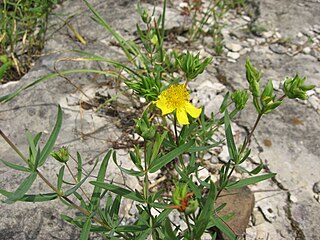
Hypericum dolabriforme, the straggling St. Johnswort or glade St. John's-wort, is a species of flowering plant in the St. John's wort family Hypericaceae native to the United States.
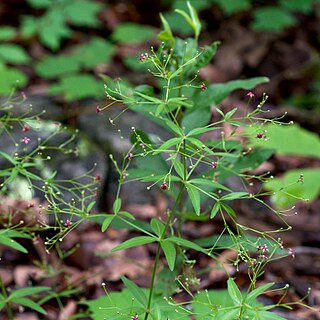
Galium arkansanum, the Arkansas bedstraw, is a plant species in the Rubiaceae. It is native to the Ozark and Ouachita Mountains of Missouri, Arkansas and Oklahoma in the United States.
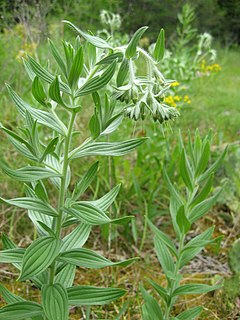
Lithospermum molle, the softhair marbleseed, is a species of flowering plant in the forget-me-not family. This species is a narrow endemic, native primarily to the Nashville Basin of Tennessee, where it is found in limestone prairies near cedar glades. There are disjunct populations in similar habitats in the Ozark Mountains of Missouri, in northwest Alabama, in Logan and Warren County, Kentucky as well as other small areas of Tennessee. Outside of Tennessee, it is very rare and perhaps no longer exists in Alabama and Kentucky due to habitat destruction. Because of its highly restricted geographic range, this species is considered vulnerable.
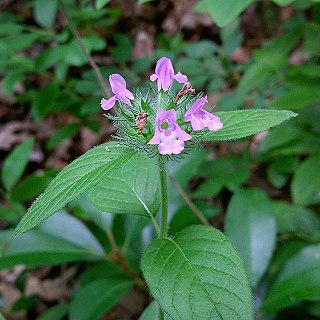
Clinopodium vulgare, the wild basil, is a species of flowering plant in the family Lamiaceae.
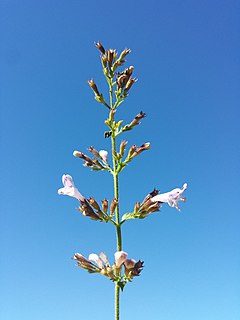
Clinopodium menthifolium, commonly known as the wood calamint or woodland calamint, is a species of flowering plant in the mint family, Lamiaceae. It is found throughout southern and central Europe from the United Kingdom and east as far as temperate parts of Asia, and as south as North Africa. It grows up to 1,700 m (5,600 ft) in elevation.



















